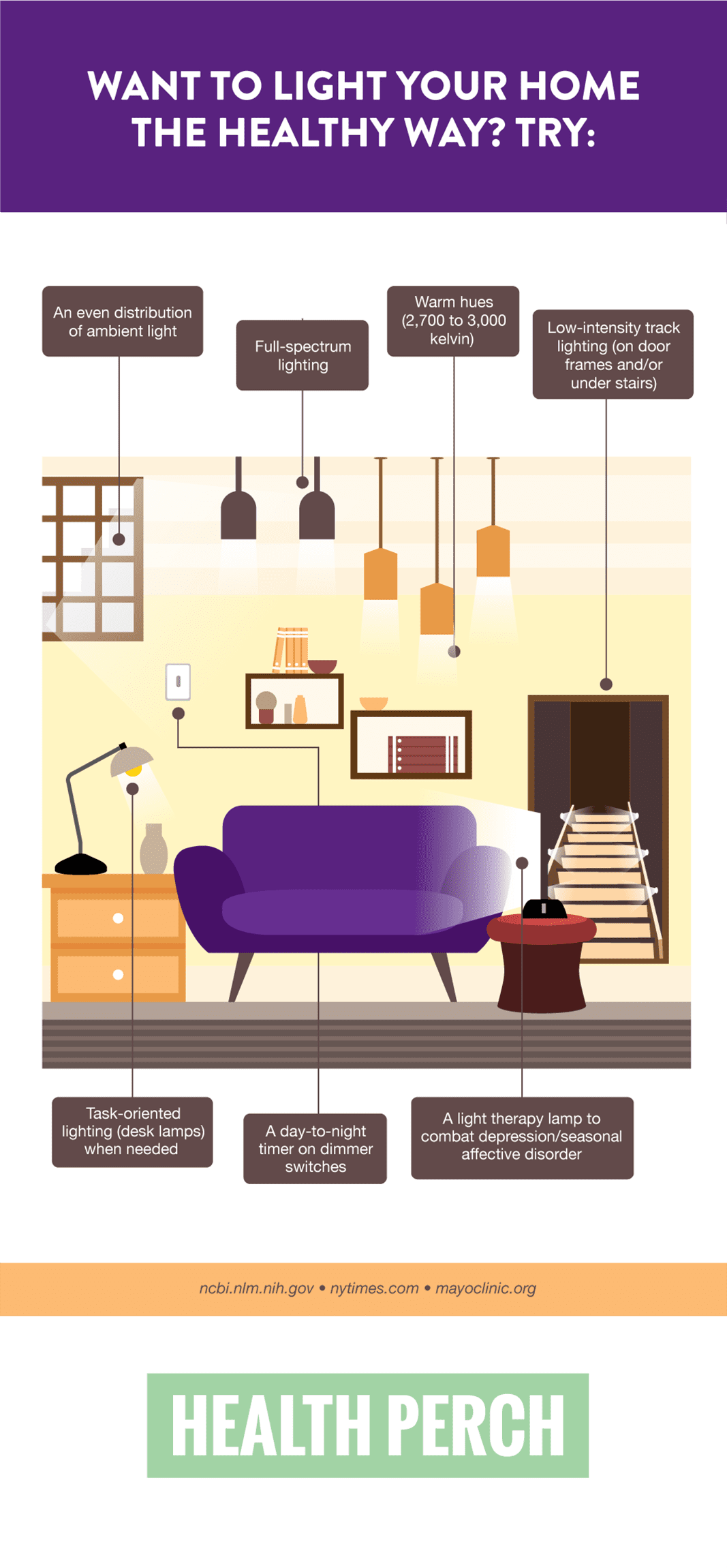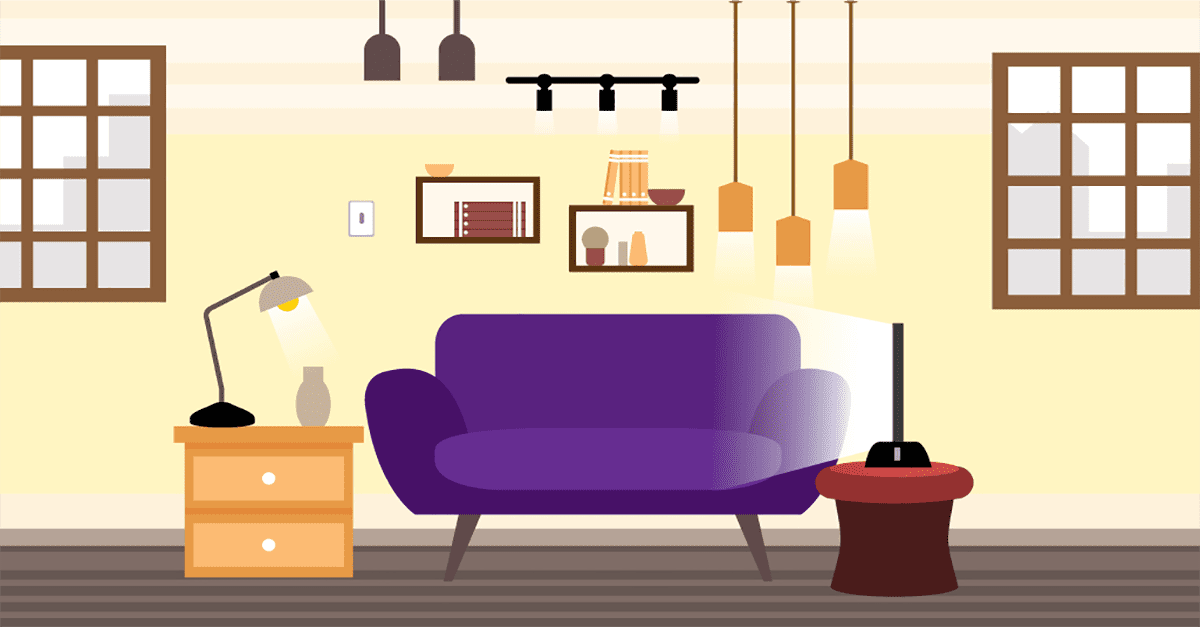Wellness often starts at home, and lighting can make a big difference in how we feel. Whether they’re from fluorescent lights humming overhead or blue light radiating from electronics, harsh beams can take a toll on our eyes, bodies, and psyches.
While harsh lighting may be unavoidable in the outside world (Hello, grocery stores!), simple changes in your home can relieve your eyes and help you feel better. Let’s take a closer look at the negative impacts of harsh light, plus tips for establishing a healthier home through strategic lighting design.
The Negative Impacts of Harsh Lighting
There are several reasons to pause and consider your home’s lighting design. Poor lighting can cause physical harm, provoke eye strain, and even exacerbate stress, while improved lighting can positively impact your mental and physical health.
A 2021 study found light plays an important role in our nervous and endocrine systems. Lighting even impacts the secretion of hormones, including the “sleep hormone” melatonin. This means light exposure can affect everything from your mental health to your body’s physical functions and sleep patterns. For instance, nighttime exposure to the blue light emitted by electronics can make it harder to fall and stay asleep.
One of the worst offenders is fluorescent lighting. A different 2021 study found that, while bright fluorescent light can increase alertness, it can also cause fatigue and provoke anxiety. Fluorescent lights also inhibit relaxation, and they can make it harder to wind down before bed and fall or stay asleep.
Exposure to harsh, bright lighting has even been tied to negative health outcomes like sleep disorders, metabolic disorders, and diabetes. Conversely, exposure to natural sunlight improves sleep health as well as physical and mental wellbeing.
Who’s Most Likely to Benefit from Better Home Lighting?
Everyone can benefit from more strategic lighting. But people who belong to these groups may want to pay extra attention to their home’s lighting design.
- Older people. Poor lighting can exacerbate poor vision, increasing the risk of trips, falls, and injuries, as well as anxiety and reduced independence.
- People with anxiety, depression, and/or seasonal affective disorder (SAD). These conditions, according to the 2021 study cited above, can be worsened by inadequate exposure to light and/or florescent light.
- Individuals who work in windowless workplaces (such as hospital workers, office workers, teachers, and naval and submarine crews). These groups may suffer from a lack of exposure to full-spectrum light, leading to disrupted sleep cycles and poorer physical and/or mental health.
Techniques to Improve Your Home’s Lighting
Now that you understand the importance of strategic lighting, it’s time to make some tweaks to your lighting at home. To craft a better lighting plan, consider these key factors.
- Spectral composition. In general, full spectrum lighting (which covers the spectrum of light from infrared to near-ultraviolet) helps most people’s eyes perceive color more accurately and can stimulate the effect of sunlight. This type of light could boost mood, increase daytime energy, and create a more comfortable environment overall.
- Color. “Cold light” (aka white light) can make it harder to relax in the evening, which may explain why it is associated with a higher chance of sleep issues. Effectively, home decorating experts suggest using a warmer light of approximately 2,700 to 3,000 kelvin in your home.
- Intensity. Harsh, bright lighting can strain the eyes and make it harder to relax. But there are times when bright lighting is necessary at home — for instance, while crafting or cooking. Use dimmer switches so you can adjust the lighting to more relaxing hues whenever brighter light isn’t required. For the same reason, it’s helpful to incorporate task lighting such as desk lamps, swivel lamps, and lamps with movable shades.
- Light distribution. Our eyes need time to adjust to changes in lighting, so extremely bright lights in one room paired with very dim lights in another can tax your eyes as you move between rooms. To minimize eye strain, use light sources with approximately the same brightness throughout the house.
- Room composition. If the room in question receives a lot of natural light, take steps to enable that. (Keep windows uncovered during the day, for example.) If the room doesn’t get much sun, use lamps to illuminate dark corners and install recessed fixtures to create adequate light for reading, studying, and other activities. Take note of any glares and try to prevent them.

In addition to the factors outlined above, consider helpful lighting options such as:
- A light therapy lamp. A light therapy box, or light box, offers support for folks with depression and/or seasonal affective disorder. For best results, bask in its glow for 20 to 30 minutes within the first hour of waking up.
- Ambient lighting. Soft, ambient lighting options (such as dimmable panel lights, low-intensity table lamps, or candles) aid biological functions, relieve eye strain, and can increase comfort.
- Low-intensity track lighting. When installed on door frames and/or under stairs or cupboards, these lights help older adults (and younger people) avoid falls while moving about during the night — without forcing their eyes to adjust to brighter lights.
- Day-to-night timer. Timers help people transition between (brighter) day and (dimmer) night illumination. While you can achieve the same thing by manually dimming the lights as the sun goes down, a timer eliminates this task and ensures you won’t forget to adjust the lighting each night.
Conclusion
Where and how we live often impacts how we feel. If you’re striving for greater wellbeing, take a moment to analyze the lighting in your home. It’s possible that better sleep, reduced eye strain, and a calmer mood are just a few strategic lighting choices away.
